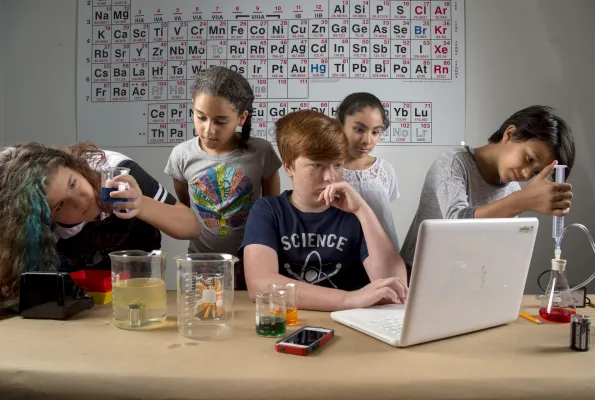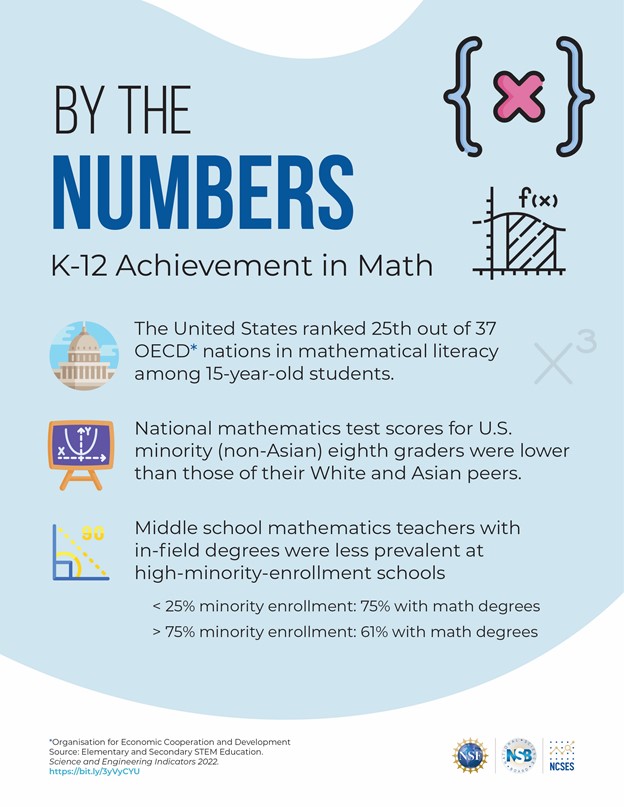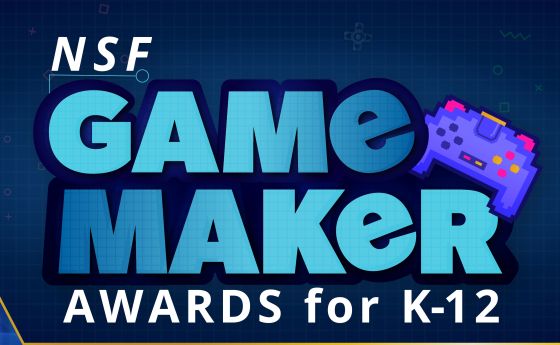
What do the data say about the current state of K-12 STEM education in the US?
A conversation with Julia Phillips of the National Science Board on the state of elementary and secondary STEM education in the nation.
The importance of a diverse STEM-educated workforce to the nation's prosperity, security and competitiveness grows every year. Preparing this future workforce must begin in the earliest grades, but the latest report from the National Science Board finds that the performance of U.S. students in STEM education continues to lag that of students from other countries.
Julia Phillips is a physicist and materials science researcher who chairs NSB's Committee on National Science and Engineering Policy, which oversees the congressionally mandated Science and Engineering Indicators report, also known as Indicators, in collaboration with NSF's National Center for Science and Engineering Statistics.
The latest Elementary and Secondary STEM Education report, the first of the 2022 Indicators reports, raises more concern about the state of STEM education in the nation and its potential impact on the economy and the U.S. standing in the world. Phillips discusses the key trends and their implications for science and education policy in the U.S.
Note: some of the conversation has been condensed and edited for clarity.
What does the report tell us about K-12 STEM education?
What we see is that the performance of children in the U.S. has not kept pace with the performance of students from other countries in science and mathematics for a decade or more. We have pretty much stayed steady, and other countries have improved dramatically. When you look at the closest economic competitors to the U.S., our scores are in last place in mathematics and in the middle of the pack in science. Math scores have not improved for more than a decade, and they're not good when you compare them to other countries.
This is just not something that we can be comfortable about. Our economy depends on math and science literacy. This is not only a concern for those with careers in those topics but also for the public at large.
You've said before that performance is "lumpy," with some groups of students performing very well and improving over time and others remaining stagnant or falling back. Where are the trouble spots?
I think it ought to be extremely disturbing to everyone in the U.S. that science and math performance is not equally distributed across the country. You see huge differences in performance based on race and ethnicity, so that Asian and white students do much better on these standardized tests than students of color. And you also see that there is a huge difference based on the socioeconomic background of students – students that are from higher socioeconomic backgrounds do much better than students from low socioeconomic backgrounds.
Data also show that the situation has only been exacerbated by the pandemic. We have a multi-year gap to pull out of just from COVID, and we were already in a weak position to begin with.
Why are the educational results so unevenly distributed?
We don't know exactly. But we can notice that certain things tend to occur at the same time.
For example, students of lower socioeconomic status or those from certain demographic groups tend to be in schools where teachers have less experience in teaching. There's separate evidence that teachers tend to get better as they get more experience.
Students from low socioeconomic status and minority backgrounds also tend to have teachers who are not originally educated in the fields that they teach, and that's particularly true in science.
Why should people care about these numbers?
Every parent should care, because careers in science and engineering are some of the best careers that a young person can pursue in terms of opportunities for making a really good living, from a certificate or associate degree all the way up through a Ph.D. You don't have to have the highest degree to make a really good living in a science and engineering field.
The second thing is that science and engineering is increasingly important for driving the U.S. economy. Many of the industries that we depend upon – including the auto industry, construction, all the way up through vaccine development – depend to an increasing level on literacy in math and science. If the U.S. is going to continue to have the wealth and prosperity that it has come to enjoy, being in the lead in many of these industries is going to be very important.
Julia Phillips on U.S. leadership in science
What can be done to turn these statistics around and improve STEM scores?
There has to be an all-hands-on-deck approach to emphasizing the importance of high-quality math and science education, beginning in the elementary grades and continuing all the way through as much education as a student gets. Communication is needed to say why it is important to have good math and science education.
NSF has prioritized programs that address this issue as well, like INCLUDES, which uses a collective approach to help broaden participation in STEM. Perhaps we could also be encouraging individuals with math and science backgrounds to go into teaching if they are drawn to that. We also need to increase the level of respect for the teaching profession.
How do you think education changed in recent decades, or even from when you were a student yourself and became interested in science?
In my own personal experience growing up in a small town in the middle of a bunch of cornfields in Illinois, I don't think I knew any practicing research scientists. But having teachers who were able to make science come alive with the things around us – whether it was nature, the stars, the gadgets in our house, whatever – they were able to make it interesting, relevant and exciting, and we were able to get a little taste for what we might be able to do. Teacher education programs must incorporate more STEM education so that elementary school teachers have the skills and comfort level they need to nurture young children's natural curiosity. NSF has funded some great research on STEM education that could be applied in the classroom, including work on teaching critical thinking, problem-solving, creativity and digital literacy.
With the internet, it is now possible for students to talk to practicing scientists and engineers, even if they don't live close to where the student is. Perhaps one good thing that the pandemic has taught us is that – if done correctly – virtual connectivity can augment educational opportunities in a very dramatic way.
I also think there needs to be communication between the various groups that are responsible for K-12 education. For the most part that happens at the local school district, and standards are often set by the state. There needs to be communication between the federal level – which is where much science and math policy is established – and the very local level where the education policy is set and the requirements for education are carried out. It is a big problem, and a big challenge. But also, a big opportunity.
When Sputnik was launched, the attention of the entire nation was riveted. We need to get a spirit of curiosity and drive to do something to change the world into every school district, both at the administration and teacher level but also on the part of the kids and their parents.






